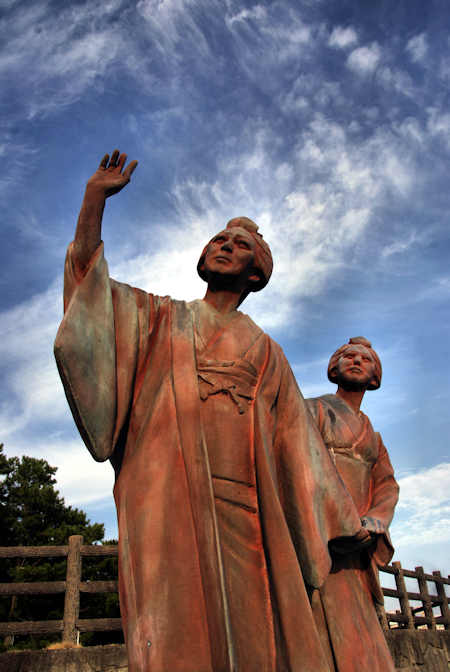Yokai
Yokai is a very broad category of creature that includes monsters, goblins, demons, in fact all and every kind of supernatural being in Japanese folklore. One man who is largely responsible for keeping yokai alive in contemporary Japanese folklore is Mizuki Shigeru whose manga and subsequent anime, tv programs and full length movies introduce many of the classic yokai as well as creating many new ones.
Shigeru's hometown, Sakaiminato in Tottori, has created the Mizuki Shigeru Road in honor of him, and there are more than 100 bronze statues of yokai along an 800 meter stretch of road.
The first statue just outside the station shows Mizuki Shigeru himself working at his desk. To the right is his most famous creation, the yokai Kitaro, though looking like a boy is actually 350 years old. Kitaro has appeared in 2 full-length movies. The yokai on the left is Kitaro's sidekick, Nezumiotoko (Ratman) who is almost as old as Kitaro and has never taken a bath so stinks.
Kappas, the water -sprites appear several times along the road.
The creature on the right is a Kirinjishi, and on the left is Shoujo, both characters are from old Chinese stories.
Nurarihyon is a yokai from folklore that may have derived from stories of a large jellyfish. In modern stories he is considered to be the commander of all yokai, and has a habit of slipping into peoples houses while they are busy making dinner and helping himself to tea and tobacco.
Momonjii is a kind of bogeyman that carries children off into the forest and is used by parents to threaten their misbehaving kids. Believed to derive from Momonga, a kind of small flying squirrel that turns into momonjii upon reaching old age.
Gangikozou is a fish-eating water monster related to the kappa.
Nuppeppo is probably from the Edo area, and to me looks like Mr Potatohead, but is actually a piece of dead flesh often found wandering in graveyards and temples.
Originaly from China, the Baku has been in Japanese folklore for a thousand years. It is a dream and nighmare eater, and it has had varying forms over the years. Baku is also the Japanese word for Tapir, and modern renditions have the yokai appearing similar to a tapir.
Nureonna has the body of a snake and the head of a woman. Exists in various sizes up to 300 meters in length, and often found on the seashore. has a habit of sucking all the blood from its victims.
for more yokai i9mages please click below
Buy Hoshi imo from Japan

















































